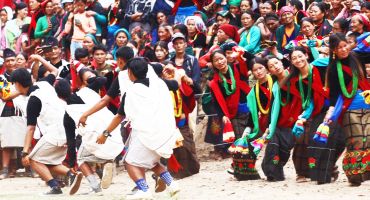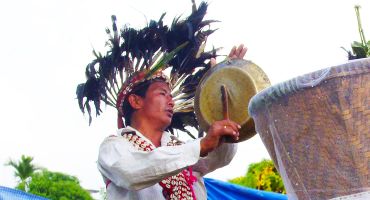‘Jim baa na macha bale khya khangu ha.’
‘My father saw a ghost when he was a child.’ Told periodically along the labyrinthine alleys of old Newari towns, these ghost stories have transferred from generation to generation. They continue to remain as frightening as ever.
Every culture has a ghost story to tell. The existence of good and bad ghosts is inherent in the collective cognizance of all communities in the Himalayas. Ghosts exist across all religious and mythological traditions. Among the Newar people, however, such archaic supernatural entities are ubiquitous, thereby steering the narratives of individual, collective, ethnic, and religious memories. Although ‘Khyah’ in the Newari language translates to ghost, it is essentially a spirit that actively participates in the set of circumstances that govern the physical world.
Khyak or Khyah, the mythical creature, is one of the central characters in Newari folklore. It is a burly, hairy, ape-like creature, prominent in children’s stories, popular in Newari society. Among the Newars, there are countless accounts of Khyah sightings, legends, tales, and publications. Khyah serves as a meaningful rhetorical character or legend that helps transmit knowledge across generational boundaries and fosters cultural associations. Usually, such terrifying creatures are symbolic of evil, but Khyah represents both good and evil and redefines Newari moral understanding of the causes and consequences of negatively valued behavior.

To the Newars, not all Khyahs are bad. Some are the protectors of the house, family, and prosperity. They are also the guardians of good fortune (Saha, in Nepali) that prevails in the house. Khyahs always dwell in the dark as they are afraid of the light. There are two types of Khyahs; white and black. The white ones are the good ones who fill the house with good fortune and happiness, while the black Khyahs are equated with bad luck and hindrances. Household Khyahs are revered in Newari houses and reside in attics or dark storerooms. This is a form of spirit worship that most Himalayan cultures adhere to. Khyahs appear in the bhandar and dhukuti, rooms where grains are stored, and where other valuables like gold and silver ornaments are kept. The resident white Khyah is supposed to bring good luck to the household.
According to Newari legend, the old Gods gave birth to the terrible Khyahs. It is said that a child was born to the old gods, and a tussle began between them to hold the baby. The struggle led to the detachment of the skin, and the child only remained with flesh and bones. Out of the flesh came Khyah, and Kavam emerged as the skeleton. The mythical twins became symbolic of the counterbalancing principles of good and evil. To control the power of the twins, the Gods created the Newari instrument called Dhimay from a tree trunk. During Khyah Pyakhan, the traditional Newari dance, dancers dressed as Khyah, dance to the beat of a Dhimay. Much like the Newari cultural faith in the existence of two halves of the universe that fit together like night and day, the Khyah twins represent the symmetry of the cosmos in motion.

Khyak stories and legends present deep insights into the affective dimension of human learning and socialization in the Newari community and the role of stories in the transfer of cultural knowledge and values. Story and myth still form an integral part of traditional forms of education among the Newari community. As a challenge to the coherent, rational model of a standardized mainstream educational archetype that inclines towards trivializing story and myth as figments of imagination, Khyaks are symbolic of Newari belief in the spirit realm and supernatural entities and play a pivotal role in their cultural narrative.
In Nepali, the words “Deuta Palnu” (Nurturing a Deity) aptly describe this tradition. Such reverence for good Khyahs comes from Newari animism traditions and practices since ancient times. In Kathmandu valley, one can find wall paintings, statues, and carvings of them – testaments to the significance of this mythical creature in Newari culture. Images of Khyaks are also placed at temples as guardians of the shrine. In Newari festivals, dancers display Khyak Pyakhan, which is a dance depicting the powers and struggles of the Khyak creatures.
The cultural, social, and spiritual significance of Khyah is reflected in the cycle of ceremony adhered to by traditions. Khyahs often make significant appearances in the Newari Gufa tradition, a ritual meant for young girls before the beginning of their menstruation. During this ritual, girls remain inside a dark room with a small doll that represents Bahra Khyah. Ever present and continuously infiltrating into the mainstream Newari culture, Khyah reaffirms the notion that physical and spiritual coexist. It endorses the idea that personal welfare in this world is caused by entities beyond the physical sphere, significant for mutual survival.
Therefore the world of spirits or ghosts is not one of wonder but of familiarity. The world of humans is only one of the multiple parallel worlds that work together to continue the process of Khyah and people. To the Newars, if one aspect of the knot is removed, the integrity of societal traditions is threatened, and all other aspects are weakened. To some, Khyahs represent the idea of good and bad in the world. To others, they are an integral part of a rich cultural heritage. Many, however, attach Kyahs to the regular terrifying stories heard and help preserve the memory of the loving grandmother who narrated these stories at night. Amidst the Newars, these stories, legends, and traditions always survive with individuals – much like the omnipresent terrifying Khyahs themselves.





Leave a Reply